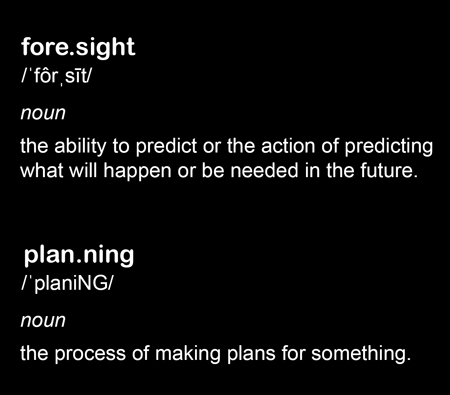
When an instructional design project falters or ultimately fails, it rarely (if not never) happens overnight. In hindsight, the signs have been present, the evidence of problems exists, and early warnings that relate to project problems and their causes are evident. Perhaps there were decisions or assumptions about the project that didn’t consider important factors, processes or people that can impact one or more phases of the instructional design process. Certain steps or phases of the instructional design process might have been disregarded or not thoroughly addressed. We call it “lack of foresight” when such signs, evidence and warnings are distorted by being “explained away”, minimized, only scanned through or ignored for any reason.
In Part 1 of this series, I covered project scope creep due to poor project communication. In this article I explore another factor that causes project delays, that is lack of foresight and planning.
Scope creep, also known as “kitchen sink syndrome” in project management refers to changes, continuous or uncontrolled growth in a project’s scope, at any point after the project begins (Komal, Bakhtawar & Janjua, 2020). If the scope of a project changes and evolves, so do its goals and objectives, requiring instructional redesign and additional rethinking of the original expected and agreed-upon learning experience development. One of the most common causes of scope creep is lack of foresight and planning (PMBOK® Guide, 2021). If not avoided or properly managed, project scope creep due to poor or no planning can make any instructional design project evolve into ineffective learning experiences. As managers of instructional design projects, we should avoid or reduce uncontrolled growth or changes in projects due to poor planning or lack of foresight.
Lack of Foresight in Instructional Design Project Management

Foresight in project management is a method of broadly envisioning the future of a project, with an emphasis on the concept of alternative futures (Carazo 2012, Goldschmidt 1984). Foresight in instructional design becomes evident when the phases of design include discussions or integrations about sustainability and legacy of the project. Foresight considers possible, plausible and probable scenarios that can impact the design, implementation or delivery of the learning project. A logic model can be a reliable source of information for project foresight since logic models are descriptions of the chain of causes and effects leading to a learning outcome of interest (Loberti and Dewsbury 2018).
Scope creep due to lack of foresight in learning project management occurs when:
- There is a lack of investment in the goals and outcomes of the project and/or the greater picture that benefits the organization. Not having full buy-in from stakeholders can cause poor participation and involvement in the instructional design process and consequently, no foresight about the project. If stakeholders fail to see why the instructional design processes are important, they are less likely to contribute or provide resources necessary to make it a successful project. From this stand point, lack of interest in the project means failing to envision the impact or future for the project.
- There is little or no appreciation of how decisions affect the future of the learning project and the organization or institution. Even if there is interest and investment in the instructional design process of a project, there might still be a lack of foresight if stakeholders fail to see “the bigger picture”. In some instances, this happens due to lack of knowledge of the instructional design process. Many stakeholders might think of instructional designers and eLearning developers as people whose job is to “convert this material into an eLearning”. Misconception- driven feedback (or lack thereof) can cause lack of foresight due to misunderstandings of the role of the instructional designer in the project (Gusukuma, Bart, Kafura & Ernst 2018). In other instances, the lack of foresight occurs due to what is known as “check-box culture”, where the project is thought of as some sort of requirement that has to be documented, hence the stakeholders have no further interest in the learning experience or its impact.
- There is a disconnection between the learners, the instructional design team and organizational or institutional goals. An inability to think holistically about the driving forces that may influence learning in a disruptive way can be the result of wrong assumptions made about the learners, the process or any aspect of the instructional design. A poorly performed (or non-existing) analysis might result in missed objectives, resulting in missed learning opportunities. Additionally, an instructional design project lacks foresight when there is a disconnection between the learning experience and the organizational or institutional goals.
- There is weak or no resilience and adaptability in the face of unknowns. Lack of foresight occurs when there is no plan for possible disruptions. Also, an instructional design project shows evidence of lack of lack of foresight when the design doesn’t provide flexibility for future organizational and cultural changes that may present critical changes to its learning environment.
How to Manage Instructional Design Projects with Considerations for Foresight
Do we have to play the role of a fortune teller to forecast scenarios that will impact the project? How do we “envision” possible, plausible and probable scenarios? We don’t blindly (or magically) guess what can go wrong on a project. Instead, we use data and our own experience to make such guesses. We use the flexibility and ability to adapt our project to specific needs to adjust our designs based on new information or events. We look at societal, organizational, and cultural changes that may present critical changes to learning environments. Below are some useful recommendations to implement and manage foresight in instructional design projects.
| Scope Creep Occurrence | Recommendations |
|---|---|
| To address lack of investment in the goals and outcomes of the project and/or the greater picture that benefits the organization |
|
| To address little or no appreciation of how decisions affect the future of the learning project and the organization or institution |
|
| To address disconnection between the learners, the instructional design team and organizational or institutional goals |
|
| To address weak or no resilience and adaptability in the face of unknowns |
|
These recommendations apply to both the project stakeholders and the members of the project management team. These recommendations are not all-inclusive, and can be adapted to specific situations. In today's workplace, organizations are constantly seeking different approaches to cope with uncertainty, and as a result, foresight as a supporting tool to long range planning is gaining popularity in all aspects of organizational development, including instructional design.
In Part 3 of this series, I’ll explore project scope creep due to poor timing and cycling.
References
- Aziz, E. E. (2014). How to secure 360 stakeholder buy-in and sustain it? Paper presented at PMI® Global Congress 2014 - North America, Phoenix, AZ. Newtown Square, PA: Project Management Institute.
- Carazo San José, J. (2012). The future of project and program management—foresight workshop. Paper presented at PMI® Global Congress 2012—North America, Vancouver, British Columbia, Canada. Newtown Square, PA: Project Management Institute.
- Goldschmidt, P.G. (1984). Long Term Planning: The Alternative Futures Approach. In: van Eimeren, W., Engelbrecht, R., Flagle, C.D. (eds) Third International Conference on System Science in Health Care. Health Systems Research. Springer, Berlin, Heidelberg.
- Kern, B. (1997). Management buy-in: how to get it. PM Network, 11(12), 32–33.
- Komal, Bakhtawar & Janjua, Uzair & Anwar, Fozia & Madni, Mustafa & Cheema, Muhammad & Malik, Muhammad & Shahid, Ahmad. (2020). The Impact of Scope Creep on Project Success: An Empirical Investigation. IEEE Access. PP. 1-1. 10.1109/ACCESS.2020.3007098.
- Luke Gusukuma, Austin Cory Bart, Dennis Kafura, and Jeremy Ernst. 2018. Misconception-Driven Feedback: Results from an Experimental Study. In Proceedings of the 2018 ACM Conference on International Computing Education Research (ICER '18). Association for Computing Machinery, New York, NY, USA, 160–168.
- Project Management Institute. (2021). A guide to the Project Management Body of Knowledge (PMBOK guide) (7th ed.). Project Management Institute.
- Silva, M. (2015). A Systematic Review of Foresight in Project Management Literature, Procedia Computer Science, Volume 64, 2015, Pages 792-799. ISSN 1877-0509.
- Wiley, et al (2012). Including the Client. Project Management for Instructional Designers. Licensed under a Creative Commons Attribution-NonCommercial-ShareAlike 4.0 International License, except where otherwise noted.

